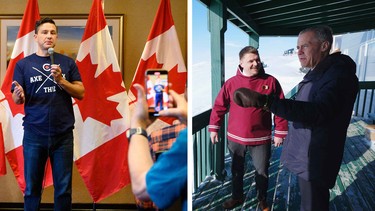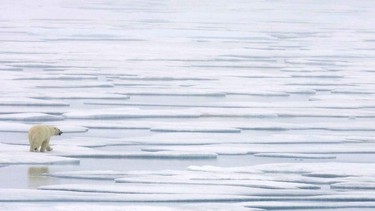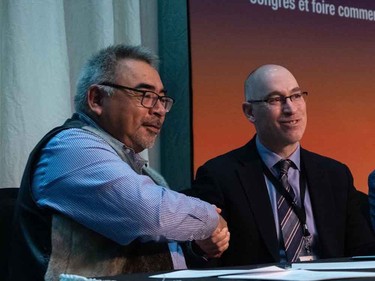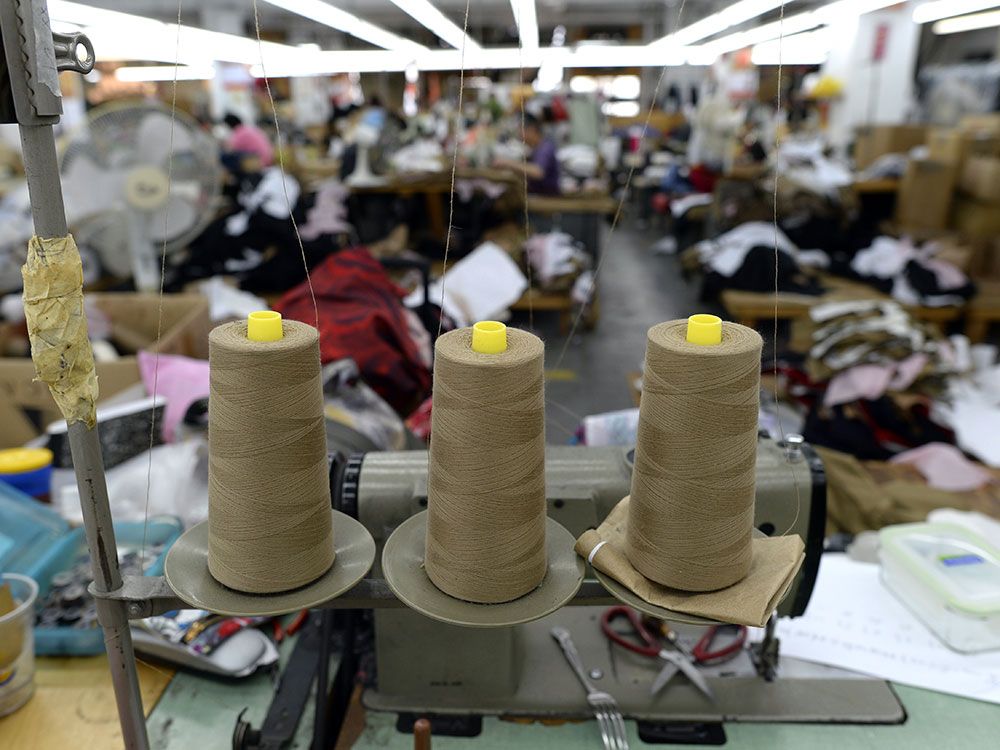Donald Trump has forced a new urgency on the campaign trail and up and down the country to unleash the North’s potential or risk Arctic sovereignty and a northern treasure house of resources
Article content
Brendan Bell knows what it is like to be ignored. It wasn’t so many months ago that the chief executive of West Kitikmeot Resources Corp., an Inuit-owned company proposing to build a road and deepwater ocean port in the Arctic, was spending a chunk of each day waiting for non-Arctic people to return his phone calls to discuss the project.
Article content
Article content
“This road is not a new idea,” he said. “Roads have a long history in the North.”
Advertisement 2
Article content
Do they ever. Yet that history can be summarized as roads — and major infrastructure projects of all types — may get proposed for the Arctic, but they generally don’t get built. No surprise then that Bell had been contending with an utterly non-urgent vibe from other people in relation to the Grays Bay Road and Port Project. That is until recently, when a lot of those same people started calling him back.
Given all roads lead to Donald Trump lately, it is no mystery why. In launching a trade war against Canada, the United States is no longer a friendly ally, at least at the top, and that is a driving reason behind why the narrative around roads that do not get built in the Arctic has shifted to one that Canada better start building roads, deepwater ports, naval installations, mines, power grids and fibre-optic networks as soon as possible or risk ceding its Arctic sovereignty and a northern treasure house of critical minerals to a foreign power.
Some of that treasure takes the form of gold, which is currently trading at around US$3,000 an ounce. Canadian gold miner Agnico Eagle Mines Ltd. believes its Hope Bay property in the Northwest Territories could produce as much as 400,000 ounces per year.
Advertisement 3
Article content
The Northwest Territories is peppered with more than 1,200 active mining claims, while Nunavut is believed to be home to up to 30 per cent of Canada’s petroleum reserves and Yukon is ranked as a top 10 region worldwide in terms of its mineral endowment, according to the Fraser Institute’s 2023 annual survey of mining companies. All told, the conversation around what all the untapped northern bounty could be worth begins in the trillions.
Article content

Evidence of this newfound sense of urgency to stop talking about the Arctic and start doing things keeps popping up in Nunavut. Liberal Leader Mark Carney, Conservative Leader Pierre Poilievre and NDP head Jagmeet Singh have all stopped in Iqaluit in recent weeks. Depending upon which party platform you pull from, the politicians have committed to more infrastructure, better collaboration with the Inuit, increased military spending, investing in energy upgrades and adequate housing and boosting Canada’s capability to unleash the North’s economic potential.
“Canadians used to be fond of the old Winston Churchill quote about Americans that they will ultimately do the right thing after trying everything else,” Bell said. “But as it pertains to the Arctic, Canada has literally tried everything else. We have tried ignoring it. We have tried underinvesting in its communities and in its infrastructure. We have tried letting the Americans be responsible for our continental defence. And, at last, we can see now that it just isn’t sustainable. The mood of the country has changed.”
Advertisement 4
Article content
Being mightily ticked at Trump and expressing your patriotism by buying Canadian products at the grocery store is a much more straightforward and inexpensive (relatively speaking) way of taking control of your fate than supercharging the economic development of the North. As the old saying goes, you need to start somewhere, but outside of a few mines dotted here and there, developing the North has barely begun at all despite decades of promises to make it happen.
Whether the current generation can drum up the will and the cash to finally dig in and get big, ambitious projects done, ones that drive Arctic and national prosperity while safeguarding Canada from international bullies, could determine the country’s long-term fate.

If that sounds alarmist, it is worth having a brief chat with Rob Huebert, a political scientist at the University of Calgary, about the Northwest Passage. In the days of yore, this shortcut between the Atlantic and Pacific oceans stoked the imagination of explorers, who would set off in search of an ice-free route and often get stuck in the ice.
Nowadays, the passage is navigable for a stretch of time in the summer and fall. The theory holds that as the world warms up and more sea ice melts, the passage will become an increasingly attractive shipping lane, so controlling it is key. Canada’s position is that the Northwest Passage belongs to Canada. The Americans, to paraphrase, have long claimed the passage as international waters.
Advertisement 5
Article content
In practice, the disagreement between neighbours has been a remarkably polite affair. A U.S. ship has never entered the passage without first informing the Canadians what it is up to. Granted, Americans tell rather than ask for permission, but they also typically request a Canadian icebreaker be somewhere nearby in case they run into any problems with the ice.
“The Americans have always understood the Northwest Passage as a security issue, which has meant keeping the Soviets, and now the Russians, away,” Huebert said.
We are now in a situation where we are completely exposed in the North
Rob Huebert, political scientist, University of Calgary
The Americans have also historically done the heavy lifting in terms of keeping the Russians away, allowing Canada to blissfully flake out and, until last year, classify the Arctic as an “area of exceptional” peace, despite Russia having an extensive network of military bases and several nuclear-powered icebreakers at its disposal.
“The Russian threat is clearly understood,” Huebert said. “Now, all of a sudden, you get Trump back and he has shown a willingness to throw his allies under the bus, and he’s also threatening the existence of Canada. We are now in a situation where we are completely exposed in the North.”
Things are bad, but that could be good for West Kitikmeot’s Grays Bay Road and Port Project. The company has received dribs and drabs of federal funding over the years to conduct road feasibility studies and the like, but there are no bulldozers on the immediate horizon.
Advertisement 6
Article content
The proposal to build a 230-kilometre all-weather road in the middle of a mineral-rich area of the central Arctic, one that would tie into ice roads and ultimately connect a proposed deepwater port, featuring a bunch of bells (maintenance sheds) and whistles (an airstrip), to Yellowknife and southern Canada requires some chicken-and-egg-type thinking.
Article content

The major mineral deposits — copper, zinc, gold and silver — do not need to be discovered. Mining companies have been aware of their existence for decades. Bell’s contention is that if you build the main road, branch roads leading to new mines will follow as the economics of developing a mine go from, “We know the copper is there, but we just can’t get to it,” to, “We know the copper is there and we now have a way of getting it to market.”
The proposed deepwater port could also serve a dual purpose. After all, the Canadian navy is going to need somewhere to dock given that the Nanisivik Naval Facility, first announced by prime minister Stephen Harper in 2007 and repeatedly scaled back since then in scope and plagued by construction delays, including a sinking wharf and a lead contractor going bankrupt, as well as rife with boneheaded, impractical design elements, such as unheated fuel tanks, still doesn’t have an opening date.
Advertisement 7
Article content
Were the Royal Canadian Navy to commit to a long-term lease agreement with West Kitikmeot, the company could take it as proof of future revenue in order to raise capital from the private sector in an arrangement Bell foresees being split 75-25 between public and private.
On that front, he has been meeting with the Department of National Defence to understand the scope of the navy’s needs. There is progress. Moving forward, a road could include a fibre-optic communications corridor and potentially even a liquefied natural gas pipeline.
Nobody is going to make an investment privately on speculation that mines in the future will come along
Brendan Bell, CEO, West Kitikmeot Resources
“Nobody is going to make an investment privately on speculation that mines in the future will come along; they’re going to need something more concrete than that,” he said. “That’s really the next piece for us to solve.”
Of course, the uncomfortable question is, how much is the road going to cost?
Bell hesitates to give a hard number because the number he is working with is a projection based on a study from 2018, but he figures if you start at $1 billion, and throw in another $400 million or so for the port, then you would be on the right track.
Building anything in the Arctic is going to involve some sticker shock. Also required is a keen understanding that the ground beneath whatever gets built — a road, port, school, town or mine — may melt. Instead of the sort of bedrock structural engineers favour when sinking construction pilings, the Arctic, particularly the western portion, is filled with permafrost, or permanently frozen ground that is now in the process of permanently unfreezing at an alarming rate.
Advertisement 8
Article content
“When we talk about building in the Arctic, foundation designers have to start to consider how much overdesigning we are going to have to do to anticipate what a building will need in 30 years’ time,” Chris Burn, a physical geography professor at Carleton University, said. “If we build things to today’s code, all is going to be well, it’ll be just fine, but then in 15 years there’s going to be a problem.”

Burn is a Brit and attended a series of lectures on permafrost as an undergraduate in the 1970s. Halfway through the second one, he knew what he wanted to do with his life, and the place to do it, at least for an English-speaking scholar, was the Canadian Arctic.
He went on to become president of the International Permafrost Association for a time, and he is somewhat of a legend in Canadian Arctic permafrost research circles. He is also the guy that northerners call to consult with on building projects, including the Inuvik-Tuktoyaktuk Highway.
The 138-kilometre, two-lane, all-weather gravel road tying the community of Tuktoyaktuk on the Arctic coast to the rest of Canada’s road network opened in 2017. The price tag was $300 million and its completion allowed Canada, 150 years post-Confederation, to claim it was connected by road from coast to coast to coast.
Advertisement 9
Article content
But beneath the proudly Canadian optics of tethering the country north to south was the chilling reality of building infrastructure in the permafrost zone.
“The ice in the ground is what holds the permafrost together,” Burn said.
Think of the ice as the glue. A new, hypothetical four-storey building built to serve an equally new, hypothetical Arctic outpost would typically be built on pilings. Current engineering wisdom allows that once pilings are sunk in the permafrost, a building is effectively frozen in place. But as the permafrost thaws, and the glue unsticks, the building could be on the move: sinking, shifting or toppling over altogether.
Roads are even more dicey. Buildings have small footprints, but future Arctic roads will traverse multiple building environments and the amount of ice-glue in the ground will vary depending on the location, Burn said.
In a landscape that is humming with, say, mining projects, the ice-glue will need to support the weight of industrial-scale trucks. As long as the glue sticks, all will be well, but should the glue lose its stickiness due to temperature increases, the road would be in big trouble and need substantial repairs while those who travel upon it could be put at grave risk.
Advertisement 10
Article content
We’re not going to be building roads for $8 million a kilometre
Chris Burn, geography professor, Carleton University
“Knowing the quantity of ice underneath the road is a really critical part of the information needed to design the road because the designers have to decide how they’re going to keep that ice frozen,” Burn said.
One bright idea has been to refrigerate the permafrost. The Shakwak corridor is a critical stretch of the Alaska Highway connecting the state, via Yukon and British Columbia, to the lower 48 states. Canada and the U.S. have long co-operated in maintaining the highway, and a big chunk of that job in recent decades has been figuring out what to do about the thawing permafrost causing gargantuan potholes, bumps and cracks, as well as warping guardrails at the highway’s edge.
The community of Beaver Creek in western Yukon piloted a project involving thermosyphons: picture a white pipe stuck in the ground next to the road that is designed to vent heat from beneath the road while carrying cold back into the permafrost. The gadgets are a relatively low-tech way of addressing thawing permafrost, but low-tech should not be confused with inexpensive.
“Beaver Creek’s thermosyphon project cost $4 million and that was for 400 metres of road, which would work out to about $8 million per kilometre,” Burn said. “We’re not going to be building roads for $8 million a kilometre. We don’t do that in Canada.”
Advertisement 11
Article content
On top of that, road maintenance in areas of thawing permafrost is already six times pricier than maintaining roads in areas where the permafrost “is stable or absent,” according to the Yukon government. Burn said more thawing permafrost is in the cards, so more Arctic architects, road designers, maintenance types and accountants will presumably be puzzling over what to do about it and how to budget for it.
Taken as a whole, a great, imagined Arctic infrastructure build-out might seem a bit daunting, but Canada has not always been afraid of dreaming big. Consider John Diefenbaker’s Northern Vision.
The country’s so-called Prairie populist prime minister uncorked a barnburner of a speech before a packed house at the Winnipeg Civic Auditorium during a 1958 election campaign that his Conservatives went on to win in a blowout. Diefenbaker, whose oratorical chops were substantial, was never finer nor more fiery that day as he spoke of a “new” Canada infused with a sense of national purpose and destiny.

“How many of you here knew the pioneers in Western Canada?” he said. “I saw the early days here, here in Winnipeg in 1909, when the vast movement was taking place into the Western plains — they had imagination. There is a new imagination now. The Arctic.”
Advertisement 12
Article content
This new Canada would be a “Canada of the North,” connected by a network of northern roads, lit up by power grids, airports, mines and hydroelectric projects, you name it, all built to tame — and exploit — the last great Canadian frontier while creating hundreds of thousands of jobs and safeguarding the country’s “independence” from you know who to the south.
It should be noted that the Inuit did not view their home as some wild, untamed frontier, nor were they consulted about Diefenbaker’s grand plan, an oversight that would have been far more egregious had the North he envisioned been built.
In reality, after a short-lived burst of activity, which produced about 100-kilometres worth of road and a railway connecting a lead and zinc mine in the Northwest Territories to a railway junction in northern Alberta that today serves as a recreation trail, Diefenbaker’s vision succumbed to ballooning costs and a chorus of barbs from its critics, including the Liberals, whose quip that he was building roads from “igloo to igloo” resonated with the less enlightened Canada of the age.
I don’t think any of us have ever shied away, on the Inuit side, from talking about what it is going to take to bring the Inuit into Canada
Natan Obed, president, Inuit Tapiriit Kanatami
Six-plus decades later, the Arctic has re-emerged as a national priority, leaving the Inuit to wonder what took us so long.
Advertisement 13
Article content
“I don’t think any of us have ever shied away, on the Inuit side, from talking about what it is going to take to bring the Inuit into Canada,” Natan Obed, president of the Inuit Tapiriit Kanatami, said. “The costs involved are going to be big.”
He said there are some basic facts about Inuit southern Canadians need to be aware of. First and foremost, while the Inuit are the “first Canadians,” they view themselves as “Canadians first.” In short, they are just as patriotic, if not more so, than most.
Obed played college hockey in the U.S. He recently bought a new pair of blades for an unprintable sum for his weekly pick-up skates in Ottawa, and he said watching Canada beat the Soviet Union in the final of the 1987 Canada Cup was among the most defining memories of his childhood.
Back then, he was in North West River, a small, predominantly Inuit town in Labrador, and had never been to an NHL game, let alone to Ontario, but cheering for his country connected him to the country beyond his front door, he said. There is a deep and affectionate bond for Canada in the North, and it is one that southern Canadians can at times appear oblivious to, assuming they even bother to think about the Arctic in the first place.
Advertisement 14
Article content
What the Arctic is not, Obed said, is an incomprehensibly vast, unmanageable space. It is home to 51 Inuit communities and its residents figured out how to live there eons ago. They view it not as a northern “wasteland,” but as a homeland with “vast potential” that they are keen to develop.
Simply put, the locals want in on the resource development action, and development begins with being able to access the resources, which requires building infrastructure of the kind Diefenbaker was talking about back in the 1950s.
The Inuit already have modern treaties and a constructive framework in place for resource development with the Canadian government. The bureaucratic heavy lifting has been done. What has been missing, Obed said, is the collective will to roll up our sleeves and get at it.
Article content

“As Inuit, we are always invoking the creation of the country, and the imagination of the founders had for building east-west connections,” he said. “At some point, the railway that was built across the country would have been considered a lot like what we’re proposing with building infrastructure that connects north and south. Yes, it is going to cost a lot of money, but it is a nation-building exercise, and if Canada seriously talks about being an Arctic nation state, it’s time that Canada really understands what that means and responds to it.”
Advertisement 15
Article content
For example, imagine you are an Inuit entrepreneur or, better yet, imagine you are Aaju Peter, a 65-year-old, Greenland-born Inuit activist, lawyer, artisan and language preservation teacher in Iqaluit.
When she is not teaching Inuktitut to daycare workers at the local college or doing online coursework for a diploma through the University of Victoria, she makes sealskin garments, everything from men’s ties to sealskin mitts to beaver hats, with fox fur trim, that retail for $495. She said her sewing machine is about the size of a coffeemaker and weighs 50 pounds, but she has to either ship it to Ottawa when it needs servicing, lug it onto a plane and fly it down herself or troubleshoot the problem and fix it.
Her point? There is no suitable repair shop in Iqaluit, and not much else in the way of basic services designed to enhance the scaling-up of a small business, or any business, and that extends to the available means of getting products to market.
There is no road to Montreal or Toronto. For shipping, it is Canada Post or bust, while online sales rely on a costly satellite internet network provider that can have reliability issues. Other challenges are even more immediate, Peter said, such as how do you budget for groceries when a box of macaroni costs 10 times what it does in the south?
Advertisement 16
Article content
The effort to simply get by in the Arctic can be significant.
Peter is in her sixties, so she has experience in handling what life throws at her and can manage a heavy workload. But for a young Arctic striver, trying to figure out how to pay rent, go to school and juggle a job or two can seem overwhelming. She is not advocating for handouts, but some of the basics need to be addressed when people talk about building infrastructure in the North.
“How can you have true sovereignty if you’re not implementing the same standards as in the rest of Canada and if you don’t have proper infrastructure?” she said. “Canada needs to want the Inuit to be Canadian, but to get there, we need to have better opportunities, better living conditions, proper financing and support. If our lives were made a bit easier, we would have a much healthier and better-educated population.”
The knock-on effect would be a northern, homegrown workforce for the imagined roads, schools, daycares, machine repair jobs, government offices, mines and ports of the Canadian Arctic future, and who would also be stakeholders, if not outright owners, of whatever the enterprise happens to be.
The challenge will be figuring out how to pay for it, and not over the course of a single political cycle, but over decades, while keeping an eye on the ultimate prize of building an Arctic that is not an afterthought, but a northern economic engine boosting the country’s overall wealth.
For those wishing to discuss further, Brendan Bell is expecting your call.
• Email: joconnor@postmedia.com
Bookmark our website and support our journalism: Don’t miss the business news you need to know — add financialpost.com to your bookmarks and sign up for our newsletters here.
Article content
Canada needs to unlock Arctic now
2025-04-08 10:00:05





